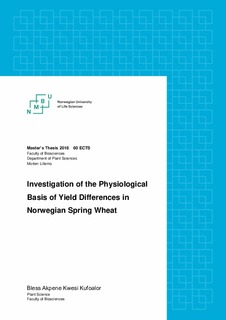| dc.contributor.advisor | Lillemo, Morten | |
| dc.contributor.advisor | Ergon, Åshild | |
| dc.contributor.advisor | Burud, Ingunn | |
| dc.contributor.advisor | Dieseth, Jon Arne | |
| dc.contributor.author | Kufoalor, Bless Akpene Kwesi | |
| dc.coverage.spatial | Norway | nb_NO |
| dc.date.accessioned | 2018-12-10T13:18:57Z | |
| dc.date.available | 2018-12-10T13:18:57Z | |
| dc.date.issued | 2018 | |
| dc.identifier.uri | http://hdl.handle.net/11250/2576975 | |
| dc.description.abstract | Norway has a total land area of 324,000 km2 of which only 3% is arable. Moreover, the climate conditions allow a short growing season for agriculture. Despite these challenges, Government policies are directed towards increasing food production and sustainability.
Wheat is a major contributor to the food and feed nutrition of the country. Furthermore, for the past 40 years, plant breeding has improved the yields of the Norwegian spring wheat cultivars and this study is set to find the physiological reasons why the new cultivars yield higher than the older ones.
The experiment consisted of 24 spring wheat cultivars which represents the history of wheat breeding in Norway. The experiment took place at two locations (Ås and Staur) in the south eastern part of the country, between May and September 2017. Two nitrogen levels of fertilization were adopted in this study, 7.5kg/daa and 15kg/daa.
Some of the physiological traits measured were chlorophyll content, light interception, plant height, harvest index and phenological phases (days to heading and days to maturity), above ground biomass and the yield components. Images were taken and analysed for canopy spectral reflectance indices and were compared with traditional data.
Grain yield was found to be strongly correlated with the number of grains per square meter, grain weight and the length of grain filling. Light interception and chlorophyll content were poorly correlated to grain yield, but their relationship was responsible for a large part of the variation between the cultivars. Spectral indices like MERIS Terrestrial Chlorophyll index and NDVI were associated with Chlorophyll content and Light interception respectively.
Future experiments should, therefore, focus much on the period from heading to maturity and collecting much data to help predict yields. | nb_NO |
| dc.description.abstract | Kun 3% av det totale landarealet (324,000 km2 ) i Norge er dyrkbar jord. I tillegg bidrar de klimatiske forholdene til en kort vekstsesong . Til tross for disse utfordringene er den statlige politikken å øke matproduksjon og bærekraft. Hvete er en hovedkilde til mat og fôr i landet. I løpet av de siste 40 årene har planteforedling forbedret avlingen til norske vårhvetesorter og denne studien har som mål å finne de fysiologiske forklaringene på hvorfor de nye sortene har høyere avling enn de eldre sortene. Forsøket besto av 24 vårhvetesorter som representerer historisk hveteforedling i Norge. Forsøket ble utført på to steder (Ås og Staur) i den sørøstlige delen av Norge mellom mai og september 2017. To nivåer av nitrogengjødsling ble brukt i studien, 7.5 kg/daa og 15 kg/daa. Noen av de fysiologiske egenskapene som ble målt var klorofyllinnhold, lysoppfanging (light interception), strålengde, kornprosent (harvest index), fenologisk stadium (dager til skyting og dager til modning), overjordisk biomasse og avlingskomponenter. Det ble tatt bilder, og analyser av bladverkets spektralrefleksjon ble utført og sammenlignet med tradisjonelle data. Det ble funnet at kornavling var sterkt korrelert med antall korn per kvadratmeter, kornvekt og lengden på kornfyllingsperioden. Studien viser også at kornavling har økt med årene. Spektrale indekser som MERIS terrestrisk klorofyllindeks og NDVI var assosiert med henholdsvis klorofyllinnhold og lysoppfanging. Framtidige forsøk bør fokusere på perioden fra skyting til modning og samle mye data for å kunne predikere avling. | nb_NO |
| dc.language.iso | eng | nb_NO |
| dc.publisher | Norwegian University of Life Sciences, Ås | nb_NO |
| dc.rights | Attribution-NonCommercial-NoDerivatives 4.0 Internasjonal | * |
| dc.rights.uri | http://creativecommons.org/licenses/by-nc-nd/4.0/deed.no | * |
| dc.title | Investigation of the physiological basis of yield differences in Norwegian spring wheat | nb_NO |
| dc.type | Master thesis | nb_NO |
| dc.description.version | submittedVersion | nb_NO |
| dc.description.localcode | M-PV | nb_NO |

